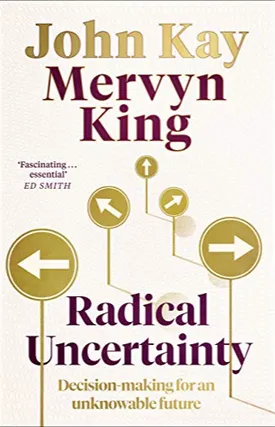Radical Uncertainty: Decision-making for an unknowable future by John Kay, Mervyn King
Radical Uncertainty, written by economists John Kay and Mervyn King, explores the concept of radical uncertainty and its implications for decision-making for an unknowable future. The authors first argue that radical uncertainty is becoming increasingly common across domains, from political and financial to humanitarian and environmental crises. The authors suggest that, in light of this heightened complexity, the traditional framework of expected utility optimization and decision modeling based on known outcomes won’t suffice. Instead, the authors introduce a 5-step approach to decision-making under radical uncertainty.
The authors define radical uncertainty as situations where very little to no information is available to make a decision. They argue that understanding such situations and framing decisions in the absence of facts or predictions is becoming increasingly essential. They call this approach a “more radical approach to risk management and measure of progress.” To illustrate their points, the authors provide several real-world examples, including how the British military prepared to respond to a nuclear attack during the Cold War, how markets reacted to the 2008 financial crisis, and how risk models failed to predict the 2016 seismic event in New Zealand.
In the second part of the book, the authors discuss their five-step approach to decision-making in radical uncertainty. The first step is to think about the issue in terms of the underlying objectives, rather than technical issues. Second, create an analysis that is as comprehensive as possible, without necessarily predicting outcomes with any amount of certainty. Third, identify and exploit what the authors call “sweet spots” -- areas of agreement on a course of action from members of the decision-making team. Fourth, make decisions quickly, even if imperfectly. Fifth, make the decision reversible, meaning that if the decision is found to be wrong the decision-makers can reverse it without irreparable harm.
The book then explores how radical uncertainty impacts organizations, specifically how managers make decisions and organizations plan for the future. To provide guidance on this topic, the authors introduce two new concepts: scenario planning and agile planning. Scenario planning is a technique that involves imagining multiple future scenarios and planning ahead based on them. Agile planning, on the other hand, is a planning model that is continuous, iterative, and flexible, allowing organizations to rapidly adapt to changing conditions. The authors argue that, together, these methods can help organizations successfully navigate the radical uncertainties they face.
The book concludes with a discussion of radical uncertainty’s implications for how we view success going forward. The authors argue that success in the future will depend less on predictions, and more on the ability to quickly assess a situation, consider multiple options, and make decisions that are reversible. They encourage organizations and individuals to think about decision-making in radical uncertainty as a learning process, rather than an all-or-nothing gamble.
In Radical Uncertainty: Decision-making for an Unknowable Future, Kay and King provide a comprehensive framework for understanding radical uncertainty and its implications for decision-making in the face of great complexity. By combining both real-world examples and theory, the authors present a thoughtful and practical guide to navigating an unknowable future.

